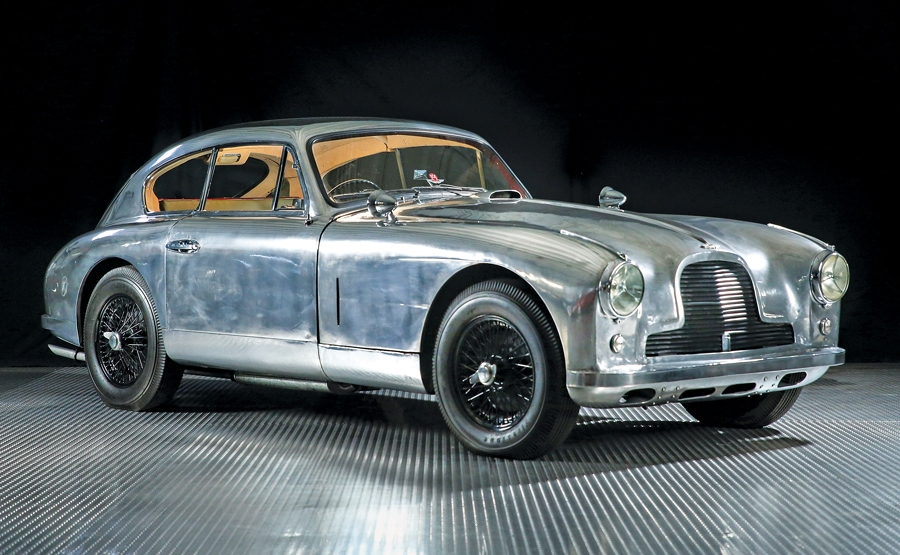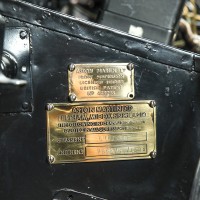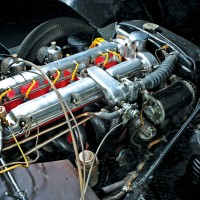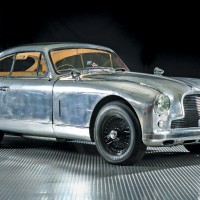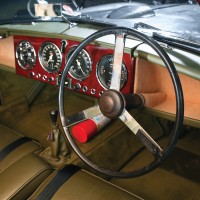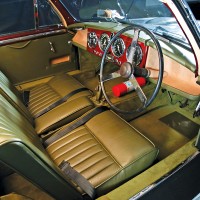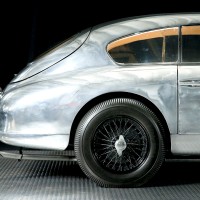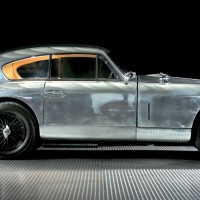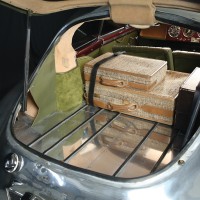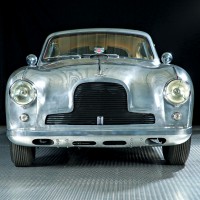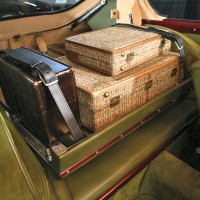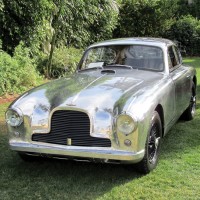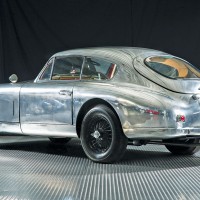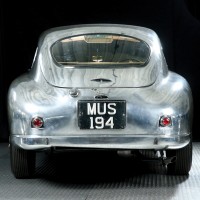The BMIHT Certificate states that this DB2/4 was completed on February 2, 1954, and it was originally sold to a Scottish customer. While its early history is unknown, its build sheet documents an early factory engine replacement.
According to Anthony Forshaw, it is believed that its current engine is that period replacement unit. Aston Service Dorset has issued an amended build sheet and new chassis plate to cement the connection. The Aston was discovered in Virginia in 2008 by the current owner, who then promptly delivered it to Francis Warwick of Lea Francis Automotive Archaeologist in West Palm Beach, FL, a specialist in British marques, for restoration.
The car was disassembled, and its alloy body was repaired where necessary. Any panels showing signs of oxidation were replaced with new metal, with the work being performed by a collector-class craftsman who was an expert in English wheels.
The underside was cleaned and undercoated, and the consignor states that the electrical system was redone, including the installation of a correct new wiring harness, a fuse block, NOS trafficators, and a rebuilt wiper motor. All instruments were rebuilt, and a new speedometer cable was installed. The fuel tank and lines were flushed, and a new fuel pump was installed. The drum brakes and carburetion were properly rebuilt, the radiator was re-cored, and a new period-correct exhaust system was fitted. The transmission was serviced, and the engine was gone through, with the technician reporting excellent compression on all cylinders. The suspension was serviced, the engine bay was repainted a textured black, the firewall was insulated, and the heater box was stripped and powder-coated. And finally, the shimmering body was hand-polished.
Inside, all new olive leather, matching cut-pile wool carpeting, and a beige wool headliner and side panels were cut, sewn, and installed. The interior wood was replaced with new burl mahogany pieces. All of the interior fasteners were replaced with stainless or chrome bits. There are new period-correct seat belts, and a new Triplex windscreen was installed, along with all-new rubber seals and weatherstripping. The window regulators were refurbished for proper operation, and all exterior brightwork was rechromed, with a new cloisonné restoration added to the badges. The car has five new 600x16-inch Firestone bias-ply tyres and tubes, and the wire wheels and grille were powder-coated black. The rear luggage area is protected by a set of leather-edged over-carpets. Receipts for the extensive work performed are available in the car’s history file.
The car is presented in stunning polished alloy, and it will be supplied with its correct bumpers and bumper-irons, front overriders, mounting hardware, and its original Scottish number plate, MUS 194. Also included will be all of the books, invoices, and records from the consignor’s ownership, a display board that includes its BMIHT Certificate, a technical data sheet, its factory record, a modified factory record, and all of its factory tools, including those fitted into the interior armrest. An Aston Martin DB2/4 of this vintage is Mille Miglia-eligible, and this wonderful example has indeed been prepared for rally events. Recent concours outings have produced Best in Class and Exceptional in Class awards.
The connoisseur searching for a sorted and strikingly beautiful DB2/4 need look no further, and whether the car remains unpainted or is returned to its original color scheme, the next owner will have an extraordinary Aston Martin that is certain to turn heads anywhere and everywhere it is seen.
SCM Analysis
Detailing
| Vehicle: | 1954 Aston Martin DB2/4 Coupe |
| Number Produced: | 565, including 102 drophead coupes |
| Original List Price: | 2,728 U.K. pounds, including tax |
| Tune Up Cost: | $1,200 to $2,400 |
| Distributor Caps: | $75 |
| Chassis Number Location: | Brass plaque in engine compartment and on top of right side chassis rail |
| Engine Number Location: | Stamped on topside of timing cover |
| Website: | http://www.amocna.org |
| Investment Grade: | C |
This car, Lot 148, sold for $205,308, including buyer’s premium, at RM Auctions’ London Auction on September 8, 2014.
On the 10th anniversary of my waxing philosophic about another “challenged” Aston Martin DB2/4 (see September 2004 “English Profile,” p. 64), the powers that be in the editorial office decided to throw me another fine bone, er, customized example. My mood has not swayed one iota about such things. I’m not a fan.
Sometimes an online catalog is all you need. My eyes still hurt from staring at Lot 148, but let’s get to the good news early. RM deserves their buyer’s and seller’s commission here. Kudos to Max Girardo and the staff, honestly, for this is what auction companies sometimes do better in an auction environment than any specialist in a boring old garage (with inspection equipment and technicians) on any given day. This Aston was well sold indeed.
An orphan has found a home. Let’s hope that this new home heals and saves our poor victim from any more abuse heaped on it by past caretakers and unkind parents. Little Orphan Aston has to yearn for “Tomorrow” no more… I hope.
Picasso’s vision of an Aston?
I wasn’t at the London sale to view this car, nor did I need to be to form an opinion about this Aston bitsa. Rarely does the word “bitsa” get thrown about in the 1950s Aston Martin World, but this car is an excellent example of just that.
“I never sell any perfect cars, but that’s all I’m ever offered,” is an often-used phrase in my office. This lot was the consignor’s opinion of what should be a perfect Aston in his or her world. I view this once-glorious, once-graceful road car as Picasso’s version of an Aston Martin MK I, a Surrealist Aston, if you will. Everything is bit “cattywampus,” as they say in Maine.
Least important is the non-matching-numbers aspect of this unit. With some simple digging around, the original engine VBE501398 was listed with past multiple owners in the AMOC club registries throughout the 1970s. Re-stamping an available body-tag so that it corresponds to a replacement motor seems a bit dubious in my view, but it wasn’t done under any veil of darkness — so no harm, no foul, I suppose. It’s just bad form.
Underdone and overdone at the same time
More importantly, who, other than hot-rodders or replica builders, polishes an aluminum car?
With it strangely unpainted, you can see the warts and imperfections, I suppose, but this reeks of an unfinished project.
Items that should have been chromed (the grille, for one) were powder-coated, smooth surfaces under the hood were finished textured black, blingy chrome bits were added all throughout the interior — along with some very shiny wood. The olive leather seemed a bit too “unusual” in shade and texture to me.
This car is an odd combination of cheating some things and overworking others. The tipping point for the Picasso “cubist” Aston was the “about to shatter at any second” steering wheel that was pictured online in all of its busted glory. I would have preferred a little less mahogany personal touch and a little more unbroken steering wheel, so I could feel a tad more confident driving this jaunty beast down to the pub — or at speed.
Can this car be saved?
The good news? The catalog claims the car has fine compression, many new mechanical parts — and I personally like the black wires.
The wheels are the touch that should be the first direction of how to now finish this car and get it back the elegant state in which it once lived. Or I suppose you could just replace the steering wheel and try and drive the stink out of it on every rally, road race and track that you’d like. Either way, please save this car from any more customizing. ♦
(Introductory description courtesy of RM Auctions.)
